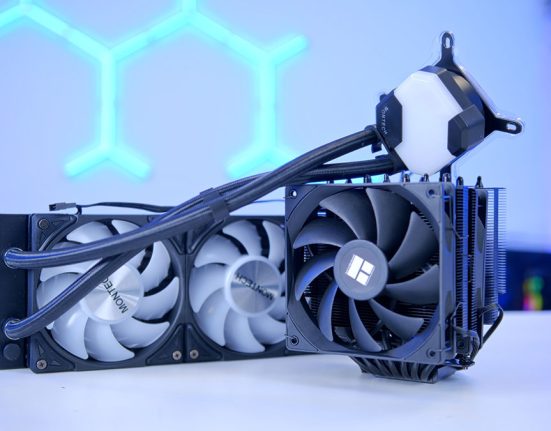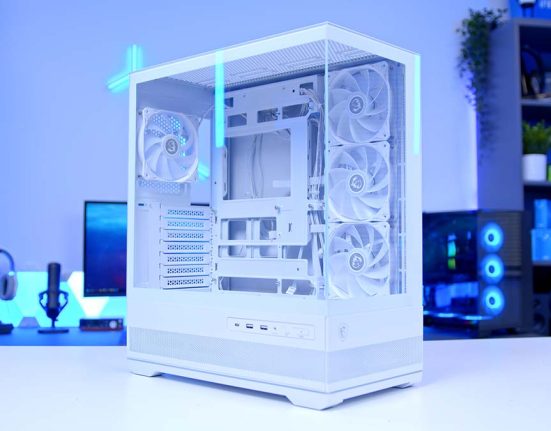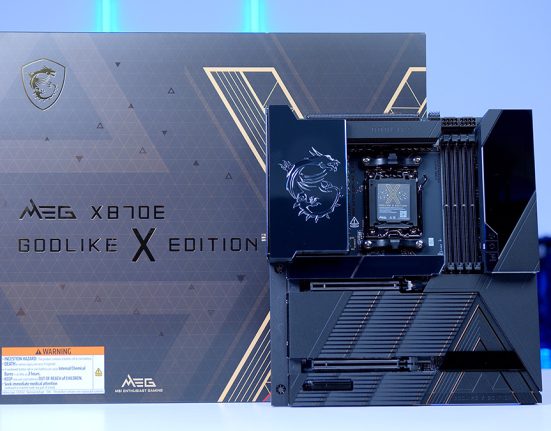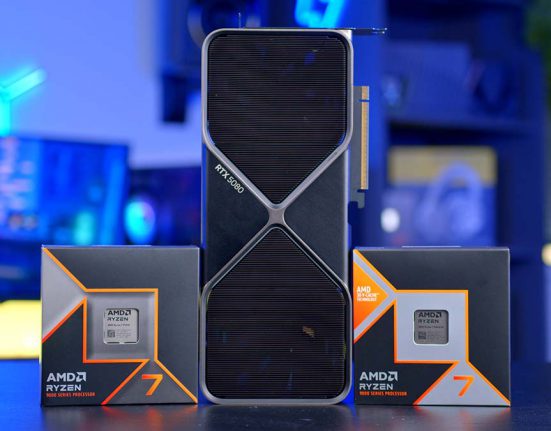The MPG X870E Carbon WiFi is a top-end motherboard released by MSI as part of the X870E chipset. Like the other X870E motherboards we’ve reviewed, it is designed to offer bountiful expansion and connectivity options while providing builders with versatile features that streamline the PC building process. With vast Gen5 support, blazing-fast IO and ample support for overclocking, the MSI MPG X870E Carbon WiFi is a monster of a motherboard. To see how it compares to other X870E motherboards, we’ve conducted a series of evaluations, analysing its various features and design elements.
The X870 and X870E motherboards hit the shelves about a month after AMD Ryzen 9000 CPUs, allowing builders to install these processors without needing a BIOS flash. Additionally, these boards bring improved features compared to the X670 and X670E chipsets, offering widespread Gen5 support USB4 across most of the IO and improved overclocking. These boards are considerably pricier than their previous-generation counterparts, which will be a point of contention for some prospective buyers.
In this review, we’ve broken down this board’s specs, design, connectivity, expansion and internal headers to see if the MSI MPG X870E Carbon WiFi is worth picking compared to the competitor options.
Buy the MSI MPG X870E Carbon WiFi on:
Specification
Regarding the specs, the MPG X870E Carbon WiFi is an ATX motherboard, retaining the same form factor as its predecessor on the X670E chipset. ATX is generally supported more than the larger E-ATX form factor, so this won’t limit case choices.
This board is immediately geared towards high-performance systems in terms of overclocking. Out of the box, the X870E Carbon WiFi supports a maximum capacity of 256GB with RAM speeds up to 8400MT/s. MSI provides several one-click profiles designed to make overclocking more accessible, so reaching a solid boost clock speed on your CPU is more than feasible. This board features an 18+2+1 VRM power phase design and ample power delivery for a solid overclock.

Expansion-wise, the MPG X870E Carbon WiFi features two Gen5 x16 slots. One runs at full x16 speeds, while the other is an x4 slot. This board also offers solid expansion options, with space for two Gen5 SSDs and two additional Gen4 drives (four slots total). It is slightly strange that the second Gen5 x16 slot doesn’t run at x8 speeds. However, MSI has likely lowered the bandwidth to save on costs.
For connectivity, the MSI MPG X870E Carbon WiFi has a bountiful set of headers on the front IO and a great selection of rear USBs. The front has five headers: two USB 2.0 and two USB 3.2 Gen1 Type-A headers. Both of these support a maximum of four ports. The final header is for USB 3.2 Gen2 Type-C, offering 20Gbps speeds.
| Specification | MSI MPG X870E Carbon WiFi |
|---|---|
| Form Factor | ATX |
| Supported Memory | 256GB DDR5 8400MT/s |
| PCI-E x16 Slots | 2 x PCI-E 5.0 1 x PCI-E 4.0 |
| PCI-E x4 Slots | 2 x PCI-E 5.0 2 x PCI-E 4.0 |
| VRM Power Phases | 18+2+1 |
| Front IO | 2 x USB 2.0 2 x USB 3.2 Gen1 Type-A 1 x USB 3.2 Gen2x2 Type-C |
| Rear IO | 2 x USB4 Type-C 9 x USB 3.2 Gen2 Type-A 2 x USB 3.2 Gen2 Type-C |
| Audio | 1 x Optical S/PDIF 2 x Audio Jacks |
| Networking | 5 Gigabit LAN 2.5 Gigabit LAN WiFi 7 |
On the rear, this board has 13 ports, two of which are USB4 Type-C. The rest are USB 3.2 Gen2, nine are Type-A ports, and two are Type-C. This is one of the most robust sets of IO we’ve seen out of all the X870 motherboards we’ve reviewed. Needless to say, I’m impressed.
The rest of the rear IO houses an optical S/PDIF port, a basic set of 3.5mm audio jacks, one for headphones out, and a microphone in. Networking is also excellent, offering a dual LAN setup (a 5 Gigabit and 2.5 Gigabit set of LAN ports) and WiFi 7 for those who prefer to avoid the hassle of wires.
What’s in the Box?
In our motherboard reviews, we always examine the additional accessories included in the box. These can streamline the PC building process and save you money in the long run.
The WiFi 7 antenna is one of the first accessories worth looking at. This MSI is pretty similar to the Gigabyte and ASUS iterations, but one of the more significant differences is the fact that it uses screws to connect to the rear IO. The Gigabyte and ASUS antennas used a snap-in connector, saving some time during building. This isn’t a deal-breaker for me, but it would have been nice to see the continuation of snap-in connectors across all manufacturers.

This board comes with a few extra accessories. In the box is a blank USB stick. You could keep this as a backup Windows installation USB or extra storage media.

The 1-3 EZ connect cable is specific to modern MSI motherboards that use the JAF header. This header combines fan power and RGB, freeing up space on the motherboard. These can be used with MSI AIO coolers and fans.

The RGB splitter cable can be handy for freeing up some headers. However, these aren’t addressable and use the 4-pin standard instead of 3-pin.

The EZ front panel cable is designed to alleviate the stress of plugging in JFP1. The pins on JFP1 can be somewhat finicky, so this cable alleviates the stress of having to write up the front panel.

Finally, a small key lets you remove the EZ M.2 clips on the board. These clips are tool-less, and depending on the build configuration, it may be helpful to move them around, so this key provides a way to do that.

MSI MPG X870E Carbon WiFi Design
Much like the previous generation of Carbon boards, the MSI MPG X870E Carbon WiFi hits the nail on the head regarding the design. This board is black from head to toe, including the PCB, RAM DIMMs and other components. It features three main heatsinks, one covering the VRMs and the rear IO, another sits on top of the primary SSD slot, and the final heatsink covers up the majority of the lower portion of the board.

These heatsinks all feature the Carbon livery, which isn’t particularly aggressive in appearance. While the Carbon WiFi is a gaming-focused motherboard, its sleek black design makes it easy to fit into a workstation hybrid setup.
This board has more RGB than some of the other X870E designs we’ve looked at previously. On top of the rear IO heatsink, the renowned MSI dragon logo lights up when the board is powered, which can be synced with the MSI RGB software. The ‘Carbon’ text on the M.2 heatsink also lights up, which is a nice touch. MSI hasn’t gone too heavy on the RGB, but there’s plenty here to bring some flair to your build.

Admittedly, I feel MSI is generally one of the better manufacturers when it comes to board aesthetics. Their boards typically feel well-rounded in design compared to ASUS, which can be a bit more aggressive in the gamer style. I’m a big fan of the Carbon. The black colouring is consistent across the entire board, and it’s nice to see some RGB that isn’t too harsh.

Connectivity Options
Graphics Card Slots
As mentioned in the specs section, the MPG X870E Carbon WiFi has a primary Gen5 GPU slot running at full x16 speeds, while the secondary Gen5 slot is limited to x4. This means that dual-GPU configurations won’t be entirely viable with this board, as the second slot doesn’t run at x8, but it still opens options for those looking to increase USB ports or add extra Gen5 storage.

M.2 Slots
M.2 expansion is substantial, with the MPG X870E Carbon WiFI featuring four slots: two Gen5 and two Gen4. The primary Gen5 slot is just below the CPU socket, covered in a larger heatsink with the ‘Carbon’ text. This heatsink is tool-less which is great to see, making it easily removable. Underneath, MSI has provided their M.2 EZ clip mechanism. Again, this is tool-less and allows you to install M.2 drives without any screws. All of the additional slots feature this mechanism.

The larger heatsink covering the three remaining drive slots is also tool-less and can be released by pushing a small latch on the left-hand side of the heatsink.
RAM DIMMs
The RAM configuration on the MSI MPG X870E Carbon WiFi is somewhat better than the top-end ASUS motherboards we’ve looked at, which is impressive. Out of the box, this board supports a max capacity of 256GB, which is restricted to 192GB on the ROG STRIX X870E-E Gaming WiFi and the ROG CROSSHAIR X870E HERO. Additionally, RAM can be overclocked to 8400MT/s, which is very strong.

The DIMM slots use single push tabs instead of two (one at the top and one at the bottom). Ultimately, this doesn’t save considerable time but provides extra stability across the DIMMs.
Rear IO
This motherboard outshines the competition in rear IO. It has thirteen high-speed ports, so there’s no USB 2.0 in sight. It features USB4, while the rest of the ports are USB 3.2 Gen2, rated up to 10Gbps speeds. There’s dual LAN, ideal for those with a home-server setup, providing options for those building a workstation system. Audio could be better on this board. Ultimately, we’d like to see a bigger selection of audio jacks for those with more complex speaker setups. Still, considering how much IO there is on this board, it’s hard to imagine that there would be space for extra audio.

I’m a big fan of the large circular buttons used for things like BIOS flashback and Clear CMOS. They’re very clearly labelled, which makes it much easier to spot them if you’re diagnosing and troubleshooting a build.
Internal Headers
CPU and Motherboard Power
The power configuration on this board is pretty standard. Most X870E motherboards we’ve reviewed (bar the X870E HERO from ASUS) feature the standard 24-pin header.

However, it’s worth highlighting that there is a PCI-E power connector towards the bottom of the motherboard. This provides more juice for the PCI Express slots for demanding GPU workloads, a unique value-add.

CPU power is, again, pretty standard. Most mid-range and top-end motherboards generally feature two 8-pin EPS CPU headers, which we see on the X870E Carbon WiFI. As always, even if you’re not overclocking, we recommend plugging in both as it spreads power delivery much better, helping thermals.

Front USB Headers
Much like the rear IO on this motherboard, the front IO is also excellent. There are five headers: two USB 2.0, two USB 3.0, and one Type-C header. The USB 2.0 headers are typically beneath the last GPU slot. These headers support four USB 2.0 ports.

The rest of the USB headers on the MPG X870E Carbon WiFi are somewhat obscured from view. They’re located beneath a larger heatsink on the right-hand side, towards the bottom of the board. All the ports are right-angled, which also keeps cables tidy. I like that MSI has attempted to hide the headers, providing a clean look to the board.

Pump and Fan Headers
Fan and Pump headers are located in their typical spots. At the top of the MPG X870E Carbon WiFi are three 4-pin PWM headers: one for the CPU fan, one for a liquid cooling setup or AIO pump, and the final is a system fan, primarily reserved for case fans.

The rest of the headers are situated primarily at the bottom of the motherboard, apart from ‘SYS_FAN2’, which is at the top right of the motherboard. It’s also worth noting that if you have a supporting cooler, you can use the JAF header, which combines RGB and PWM fan control into one, which is incredibly useful.

RGB Headers
Regarding RGB, this board offers three addressable 3-pin headers, an RGB LED connector, and a 4-pin header. These connections are pretty dispersed around the board. The first ARGB header is at the bottom left, and the second sits at the bottom right, close to the power button. The final header is at the top right, just above the Q-Code LED.

It’s good to see three addressable RGB headers. We’d love to see more, but considering the MPG X870E Carbon WiFi comes with splitters, there’s ample room for many RGB components.
SATA Data Ports
Much like the USB headers on this board, SATA data is slightly obscured. The four SATA data ports on the X870E Carbon WiFi are underneath the large heatsink. These are right-angled and provide additional options for those with older SATA storage devices.
Building with the MPG X870E Carbon WiFi
Building a PC with the MPG X870E Carbon WiFi is an enjoyable and straightforward experience. The main takeaway of this board, and the vast majority of X870E options, is that they’re specifically designed to make building a PC easy. The tool-less features streamline several elements of the building process, which may take additional time and add hassle on other boards.
The fact that the heatsinks are tool-less makes installing an SSD relatively easy, and it saves us having to screw them in. This is particularly handy for content creators likely to have plenty of storage. Some headers are obscured and right-angled, making cable management simple, especially if you’re threading them to the back of a case. There’s also minimal risk of clearance issues because the X870E Carbon WiFi is an ATX board supported across most modern cases.
Putting together a high-end PC with the MSI MPG X870E Carbon WiFi was incredibly enjoyable. While the X670E brought along some excellent features, the X870E range has seen significant refinement, making it a highly competitive choice if you want to avoid hassle.
Features We Like
DIY-Friendly Features
While geared to enthusiasts, the MSI MPG X870E Carbon WiFi is designed to make building a PC hassle-free. It offers a range of versatile tool-less features, such as the M.2 EZ clip and GPU release button. Additionally, those looking to debug their PC can leverage BIOS flashback and Clear CMOS with the click of a button. This board also has a Q-Code LED and EZ Debug lights, which allow you to get to the root of the issue much quicker.

Dual LAN Support
It’s pretty rare to see Dual LAN support on a gaming motherboard. While a board like the ROG CROSSHAIR X870E HERO offers dual LAN support, it’s one of the most expensive boards you can buy, whereas the Carbon X870E WiFi is a upper mid-range offering. It’s great to see dual Ethernet ports, as they provide more versatility for those looking to build a gaming-workstation hybrid.

Features We Don’t Like
The Second GPU Slot Doesn’t Support x8 Speeds
While this isn’t a deal-breaker for us, it is worth highlighting that the second Gen5 GPU slot only supports x8 speeds at the maximum. This limits expansion to a degree, as some builders would benefit from having a second x8 slot for more USB4 ports or 10 Gigabit LAN expansion.

JAF Header is Proprietary to MSI
While the JAF header offers a unique proposition, this connector only works with specific MSI components. It would be great if this header worked with other CPU coolers, but at the time of writing, it’s fairly niche unless you’re solely buying MSI coolers and fans.

Conclusion
MSI MPG X870E Carbon WiFi
Product Name: MPG X870E Carbon WiFi
Brand: MSI
-
Features
-
Design
-
Performance
-
Value For Money
Summary
The MSI MPG X870E Carbon WiFi is an excellent top-end motherboard built for a top-end system. It offers a fantastic set of features, which includes dual LAN ports, a bountiful set of high-speed rear IO, a vast selection of tool-less sockets and slots, and a range of internal headers, allowing for plenty of different build configurations. Furthermore, the MPG X870E Carbon WiFi has a sleep black design with customisable RGB, providing a way to spice up the look of your build. I was especially impressed with how much of this board is tool-less as well, which includes the larger heatsink towards the middle of the board.
All in all, I think the only major caveat to consider is its price. Carbon boards are considered one of the more high-end options, which means as a result, they tend to be a fair bit more expensive compared to the ‘Tomahawk’, ‘Mortar’, and ‘Pro’ ranges that MSI also offers. However, if you’re building a PC prioritising strong performance, the MSI MPG X870E Carbon WiFi is definitely an option we’d recommend looking at.
Pros
✅ Dual LAN support
✅ Excellent rear IO
✅ Easy to build with
Cons
❌ JAF header is niche
❌ Only one x16 slot
❌ Expensive



![FI_[DP056] Antec flux M + 9060XT](https://geekawhat.com/wp-content/uploads/2025/12/FI_DP056-Antec-flux-M-9060XT-551x431.jpg)




